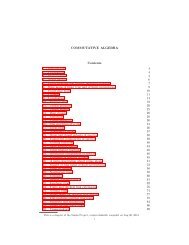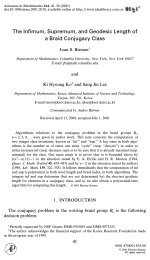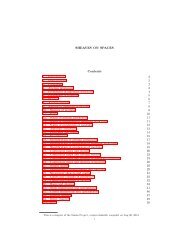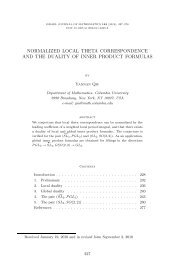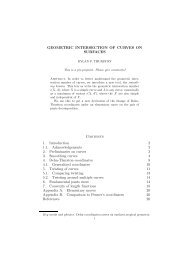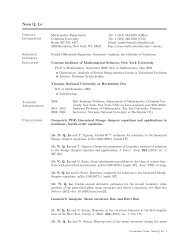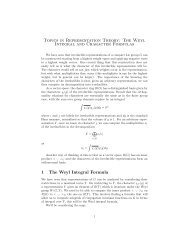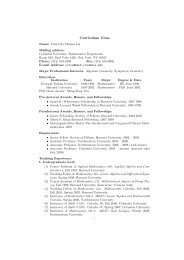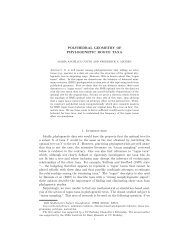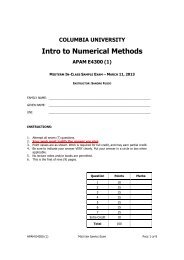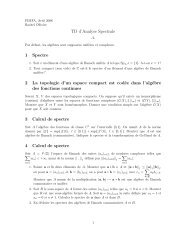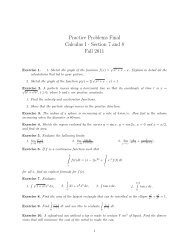INJECTIVES Contents 1. Introduction 1 2. Modules ... - Stacks Project
INJECTIVES Contents 1. Introduction 1 2. Modules ... - Stacks Project
INJECTIVES Contents 1. Introduction 1 2. Modules ... - Stacks Project
You also want an ePaper? Increase the reach of your titles
YUMPU automatically turns print PDFs into web optimized ePapers that Google loves.
<strong>INJECTIVES</strong> 3<br />
The essential idea is that A is “small” relative to the long chain of compositions<br />
B1 → B2 → . . . , so that it has to factor through a finite step. A more general<br />
version of this lemma can be found in Sets, Lemma 7.<strong>1.</strong> Next, we generalize this<br />
to the category of modules.<br />
Definition 3.4. Let C be a category, let I ⊂ Arrow(C), and let α be an ordinal. An<br />
object A of C is said to be α-small with respect to I if whenever {Bβ} is a system<br />
over α with transition maps in I, then the map (3.0.1) is an isomorphism.<br />
In the rest of this section we shall restrict ourselves to the category of R-modules<br />
for a fixed commutative ring R. We shall also take I to be the collection of injective<br />
maps, i.e., the monomorphisms in the category of modules over R. In this case, for<br />
any system {Bβ} as in the definition each of the maps<br />
Bβ → colimβ∈α Bβ<br />
is an injection. It follows that the map (3.0.1) is an injection. We can in fact<br />
interpret the Bβ’s as submodules of the module B = colimβ∈α Bβ, and then we<br />
have B = <br />
β∈α Bβ. This is not an abuse of notation if we identify Bα with the<br />
image in the colimit. We now want to show that modules are always small for<br />
“large” ordinals α.<br />
Proposition 3.5. Let R be a ring. Let M be an R-module. Let κ the cardinality<br />
of the set of submodules of M. If α is an ordinal whose cofinality is bigger than κ,<br />
then M is α-small with respect to injections.<br />
Proof. The proof is straightforward, but let us first think about a special case. If<br />
M is finite, then the claim is that for any inductive system {Bβ} with injections<br />
between them, parametrized by a limit ordinal, any map M → colim Bβ factors<br />
through one of the Bβ. And this we proved in Lemma 3.3.<br />
Now we start the proof in the general case. We need only show that the map<br />
(3.0.1) is a surjection. Let f : M → colim Bβ be a map. Consider the subobjects<br />
{f −1 (Bβ)} of M, where Bβ is considered as a subobject of the colimit B = <br />
β Bβ.<br />
If one of these, say f −1 (Bβ), fills M, then the map factors through Bβ.<br />
So suppose to the contrary that all of the f −1 (Bβ) were proper subobjects of M.<br />
However, we know that<br />
<br />
−1<br />
f (Bβ) = f −1 <br />
Bβ = M.<br />
Now there are at most κ different subobjects of M that occur among the f −1 (Bα),<br />
by hypothesis. Thus we can find a subset S ⊂ α of cardinality at most κ such that<br />
as β ′ ranges over S, the f −1 (Bβ ′) range over all the f −1 (Bα).<br />
However, S has an upper bound α < α as α has cofinality bigger than κ. In<br />
particular, all the f −1 (Bβ ′), β′ ∈ S are contained in f −1 (Bα). It follows that<br />
f −1 (Bα) = M. In particular, the map f factors through Bα. <br />
From this lemma we will be able to deduce the existence of lots of injectives. Let<br />
us recall the criterion of Baer.



